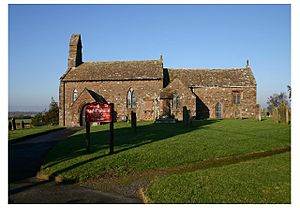St Mungo's Church, Bromfield facts for kids
Quick facts for kids St Mungo's Church, Bromfield |
|
|---|---|

St Mungo's Church, Bromfield, from the south
|
|
| Lua error in Module:Location_map at line 420: attempt to index field 'wikibase' (a nil value). | |
| OS grid reference | NY 175 470 |
| Location | Bromfield, Cumbria |
| Country | England |
| Denomination | Anglican |
| History | |
| Status | Parish church |
| Dedication | Saint Mungo |
| Architecture | |
| Functional status | Active |
| Heritage designation | Grade I |
| Designated | 11 April 1967 |
| Architectural type | Church |
| Style | Norman, Gothic |
| Specifications | |
| Materials | Sandstone rubble Sandstone slate roof |
| Administration | |
| Parish | Bromfield |
| Deanery | Solway |
| Archdeaconry | West Cumberland |
| Diocese | Carlisle |
| Province | York |
St Mungo's Church is a very old church located in Bromfield, a village in Cumbria, England. It is an active Anglican parish church, meaning people still go there for services. The church is considered very important historically. It is a "Grade I listed building", which means it is a special building protected for its history and architecture.
Contents
History of St Mungo's Church
The church building is incredibly old, dating back to the 12th century. That is over 800 years ago! Over the next two centuries, parts of the church were added or changed. Later, in the 1800s and early 1900s, some parts were repaired and updated. The church is named after Saint Mungo, also known as Kentigern. He was a saint from the 6th century.
Architecture of the Church
Outside the Church
St Mungo's is built from red sandstone rubble, which is a type of rock. Its roof is made of sandstone slate. The church has pointed roof sections called gables. On top of these gables are decorative stone shapes called cross finials.
The church has a main area called a nave with a side section called a north aisle. There is also a small entrance area called a south porch. A small room for clergy, called a north vestry, is also present. The front part of the church, the chancel, has two side chapels.
On the west gable, there is a twin bellcote, which holds two bells. On the east gable, there is another bellcote for the angelus bell. The porch has a special doorway from the Norman period. It is decorated with a zigzag pattern.
On the east wall of the nave, you can see parts of a Norman frieze. This is a decorative band with saltire crosses. The church originally had side wings called transepts. Due to later additions, these are now east of the chancel arch. The north transept is now part of the aisle.
The south chapel was once a private chapel. It was later walled off from the chancel. Now, it is a memorial to those who died in the First World War. It is known as St George's chapel. This south chapel is also called the Crookdake Chapel. It contains a special stone slab for Adam Crookdake, who died in 1304.
Inside the Church
The font, used for baptisms, dates from the 12th century. It sits on a hexagonal base. In the south wall, there is a piscina, which is a basin for washing sacred vessels. There are also aumbries, which are small cupboards, on each side of the altar.
The wooden benches (pews), the rail around the altar, and the screen behind the altar were added in the 19th century. The church also has an 18th-century Royal coat of arms. On the walls, you can see memorial plaques from the 18th and 19th centuries. Inside the porch, there are pieces of a medieval cross and old grave slabs.
External Features of St Mungo's
In the churchyard, there is the Bromfield War Memorial. This memorial remembers 14 local servicemen who died in the First World War. It also remembers one person lost in the Second World War. The memorial was first shown to the public on May 17, 1920. It is also a Grade II listed structure, meaning it is historically important.
To the north of the church, there is a holy well. This well is also dedicated to St Mungo. Over the well, there is a round sandstone wellhead with a cone-shaped stone cap. This structure was built in 1878 and is also listed as Grade II.
See also
- Grade I listed churches in Cumbria
- Listed buildings in Bromfield, Cumbria

